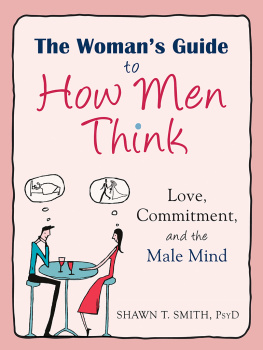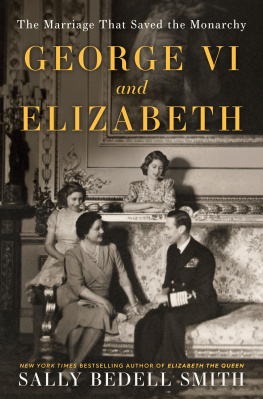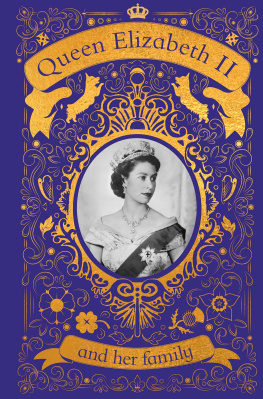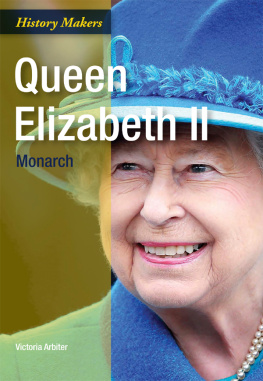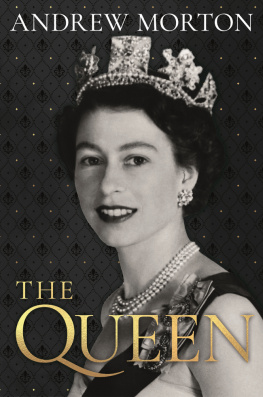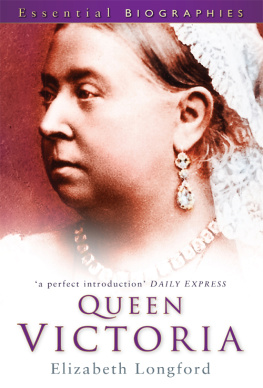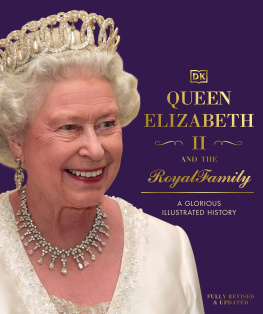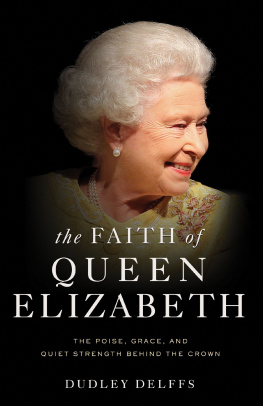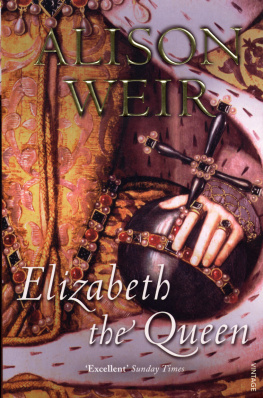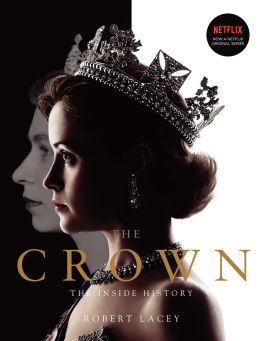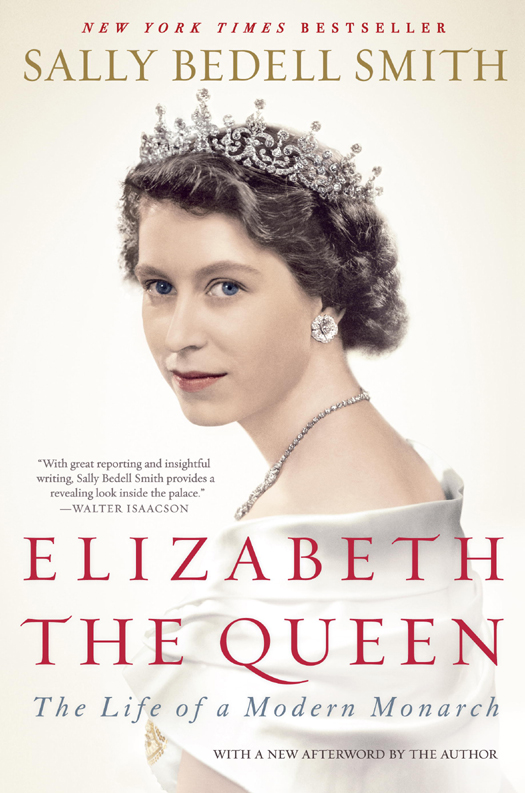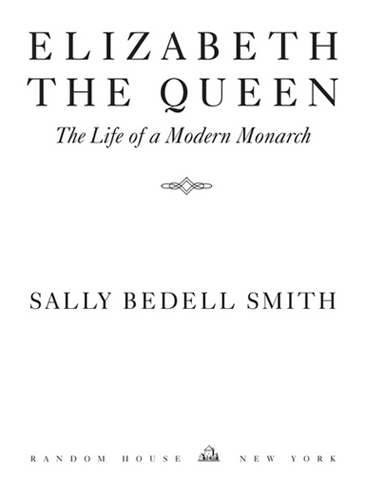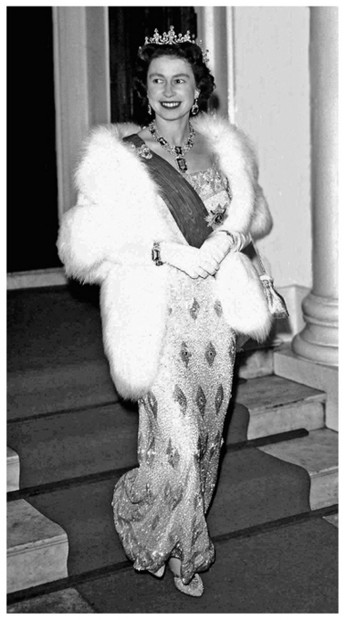
The Queen leaving the Belgian Embassy in London, 1963. Reginald Davis MBE (London)
Copyright 2012 by Sally Bedell Smith
All rights reserved.
Published in the United States by Random House, an imprint of The Random House Publishing Group, a division of Random House, Inc., New York.
R ANDOM H OUSE and colophon are registered trademarks of Random House, Inc.
Library of Congress Cataloging-in-Publication Data
Smith, Sally Bedell.
Elizabeth the Queen : inside the life of a modern monarch / Sally Bedell Smith.
p. cm.
eISBN: 978-0-679-64393-7
1. Elizabeth II, Queen of Great Britain, 1926 2. Great BritainHistoryElizabeth II, 1952 3. QueensGreat BritainBiography. I. Title.
DA490.S55 2011
941.084092dc23
[B]
2011023661
www.atrandom.com
Cover photograph: Yousuf Karsh
v3.1_r6
From The Opening of Parliament,
M ARY W ILSON ,
wife of Harold Wilson,
Prime Minister, 196470 and 197476

They love her for her wisdom and her pride,
Her friendship and her quiet majesty;
And soon the streets of Britain will be thronged
With crowds rejoicing in her Jubilee
But as the cool unfaltering voice reads on,
A different picture forms upon the air
A small quick figure, walking all alone
Across a glen studded with standing deer
She notes a crumbling wall, an open gate,
With countrywomans eyes she views the scene;
Yet, walking free upon her own estate
Still, in her solitude, she is the Queen
She sort of expands when she laughs.
She laughs with her whole face.
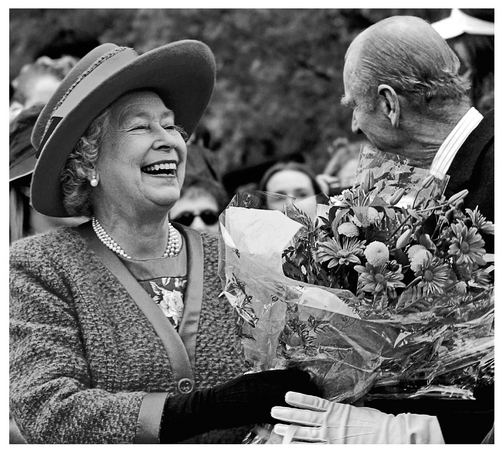
Queen Elizabeth II and Prince Philip, the Duke of Edinburgh, in New Brunswick, Canada, during her Golden Jubilee celebrations, October 2002. Norm Betts/Rex USA
CONTENTS
PREFACE
A T THE END OF THE WEDDING OF P RINCE W ILLIAM AND C ATHERINE Middleton on April 29, 2011, the radiant couple turned before walking down the aisle at Westminster Abbey and stood before his grandparents, Queen Elizabeth II and Prince Philip. The newlyweds were celebrated for their romantic love match, and for the young princes determination to marry his soul mate despite her being a commonerhaving neither royal nor aristocratic origins. The bride and groom gave a low curtsy and neck bow to the Queen, who looked sturdy and stoic at age eighty-five. She signaled her approval with an almost imperceptible nod.
Seventy-two years earlier the Queen had made a similarly independent decision about love. When she was only thirteen, on the first afternoon she spent with eighteen-year-old Prince Philip of Greece, a strikingly handsome but impecunious British naval officer in training, Elizabeth fell in love. Eight years later they married under the same Gothic arches of Westminster Abbey. While everything else in the life of Lilibet, as she was called, was laid out for her, she made the most important decision on her own, against the wishes of her mother, who preferred a titled English aristocrat. She never looked at anyone else, said Elizabeths cousin Margaret Rhodes.
It was a sign of remarkable certitude on the part of then-Princess Elizabeth, not to mention strength and confidence in a girl so young. But that unwavering decision is just one of many surprising aspects I discovered about the woman who has reigned for sixty years as Queen of the United Kingdom of England, Wales, Scotland, and Northern Ireland, along with fifteen other realms and fourteen territories around the world. Her role and how she manages to perform it seemed to me to defy rational explanation: a hereditary position consecrated by God, embodying a multicultural and multifaith nation far different from the homogenous land ruled by her predecessors over the thousand-year history of the British monarchy. I understood that much of her life is ceremonial, an unvarying routine of yearly set pieces that date from the time of Queen Victoria. A singular and internationally famous figure, Elizabeth II is the Western worlds longest-serving leaderseemingly as familiar, predictable, and unchanging as she is dutiful.
In her epic life, the Queen has played her part like a great actressthe only person about whom it can truly be said that all the world is a stage. Billions have watched her evolve from a beautiful ingenue to a businesslike working mother to a wise grandmother. When she was twenty-eight years old and had been on the throne for three years, her first private secretary, Sir Alan Lascelles, said, People will not realize for years how intelligent she is. Eventually it will become an accepted national fact. Yet while her public persona conveys gravitas, she has concealed much of that intelligence, much of her personality and humor. Behind her enigmatic and dignified facade resides a largely unknown woman.
Her private side took me totally by surprise, said Howard Morgan, an artist who painted the Queens portrait in the 1980s. She talks like an Italian. She waves her hands about. She is enormously expressive. Friends and family have often witnessed the joie de vivre seldom seen in publicblowing bubbles during a birthday party at the London Aquarium, belting out songs while perched atop a wooden box on an island in the Outer Hebrides, jumping up to serve the American artist George Frolic Weymouth from the buffet in a dining room at Windsor Castle. She stacked the plates! Weymouth recalled, which is what we were taught never to do when we were growing up.
During informal conversation her eyes sparkle, her voice is merry and warm. You can hear her laughter sometimes throughout the house, said Tony Parnell, the former foreman at Sandringham, the monarchs estate in Norfolk. It is a joyous laugh.
At five foot four, the Queens small stature is another surprise to people seeing her for the first time. Yet like her great-great-grandmother Queen Victoria, who barely reached five feet, she has the kind of bearing that makes her size beside the point. She emphasizes her authority by walking at what her longtime dress designer Norman Hartnell called her intentionally measured and deliberate pace.
Equally paradoxical is the Queens becoming humility, a trait inculcated in her early years. She can uphold the identity of herself as Queen and still be humble, said Margaret Rhodes. Her inner modesty stops her getting spoiled. When the Queen goes to the theater she tries to arrive unannounced after the house lights have gone down. One of her former private secretaries described how odd it was to watch her sidle into a room. She doesnt ever try to make an entrance. If someone else is being celebrated, she effortlessly slips into the background. When her cousin Lady Mary Clayton had her ninetieth birthday party in December 2007, a caricaturist memorialized the occasion with a cartoon. Marys figure is the largest, in the center, while the bespectacled Queen is tucked in among the others in the last row.







